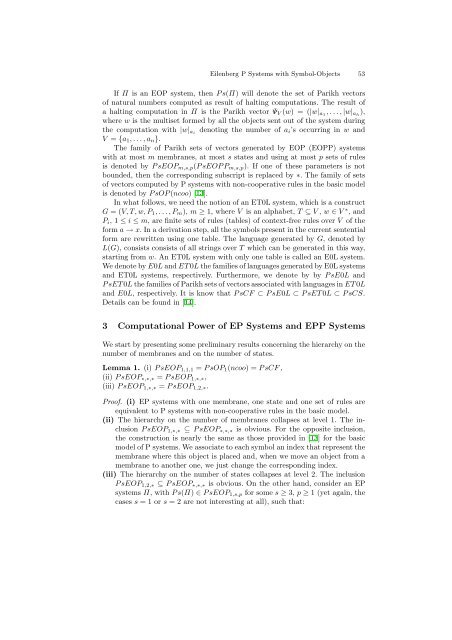LNCS 2950 - Aspects of Molecular Computing (Frontmatter Pages)
LNCS 2950 - Aspects of Molecular Computing (Frontmatter Pages)
LNCS 2950 - Aspects of Molecular Computing (Frontmatter Pages)
Create successful ePaper yourself
Turn your PDF publications into a flip-book with our unique Google optimized e-Paper software.
Eilenberg P Systems with Symbol-Objects 53<br />
If Π is an EOP system, then Ps(Π) will denote the set <strong>of</strong> Parikh vectors<br />
<strong>of</strong> natural numbers computed as result <strong>of</strong> halting computations. The result <strong>of</strong><br />
a halting computation in Π is the Parikh vector ΨV (w) =(|w|a1,...,|w|ah ),<br />
where w is the multiset formed by all the objects sent out <strong>of</strong> the system during<br />
the computation with |w|ai denoting the number <strong>of</strong> ai’s occurring in w and<br />
V = {a1,...,an}.<br />
The family <strong>of</strong> Parikh sets <strong>of</strong> vectors generated by EOP (EOPP) systems<br />
with at most m membranes, at most s states and using at most p sets <strong>of</strong> rules<br />
is denoted by PsEOPm,s,p(PsEOPPm,s,p). If one <strong>of</strong> these parameters is not<br />
bounded, then the corresponding subscript is replaced by ∗. The family <strong>of</strong> sets<br />
<strong>of</strong> vectors computed by P systems with non-cooperative rules in the basic model<br />
is denoted by PsOP(ncoo) [13].<br />
In what follows, we need the notion <strong>of</strong> an ET0L system, which is a construct<br />
G =(V,T,w,P1,...,Pm), m ≥ 1, where V is an alphabet, T ⊆ V , w ∈ V ∗ ,and<br />
Pi, 1≤ i ≤ m, are finite sets <strong>of</strong> rules (tables) <strong>of</strong> context-free rules over V <strong>of</strong> the<br />
form a → x. In a derivation step, all the symbols present in the current sentential<br />
form are rewritten using one table. The language generated by G, denoted by<br />
L(G), consists consists <strong>of</strong> all strings over T which can be generated in this way,<br />
starting from w. An ET0L system with only one table is called an E0L system.<br />
We denote by E0L and ET0L the families <strong>of</strong> languages generated by E0L systems<br />
and ET0L systems, respectively. Furthermore, we denote by by PsE0L and<br />
PsET0L the families <strong>of</strong> Parikh sets <strong>of</strong> vectors associated with languages in ET0L<br />
and E0L, respectively. It is know that PsCF ⊂ PsE0L ⊂ PsET0L ⊂ PsCS.<br />
Details can be found in [14].<br />
3 Computational Power <strong>of</strong> EP Systems and EPP Systems<br />
We start by presenting some preliminary results concerning the hierarchy on the<br />
number <strong>of</strong> membranes and on the number <strong>of</strong> states.<br />
Lemma 1. (i) PsEOP1,1,1 = PsOP1(ncoo) =PsCF,<br />
(ii) PsEOP∗,∗,∗ = PsEOP1,∗,∗,<br />
(iii) PsEOP1,∗,∗ = PsEOP1,2,∗.<br />
Pro<strong>of</strong>. (i) EP systems with one membrane, one state and one set <strong>of</strong> rules are<br />
equivalent to P systems with non-cooperative rules in the basic model.<br />
(ii) The hierarchy on the number <strong>of</strong> membranes collapses at level 1. The inclusion<br />
PsEOP1,∗,∗ ⊆ PsEOP∗,∗,∗ is obvious. For the opposite inclusion,<br />
the construction is nearly the same as those provided in [13] for the basic<br />
model <strong>of</strong> P systems. We associate to each symbol an index that represent the<br />
membrane where this object is placed and, when we move an object from a<br />
membrane to another one, we just change the corresponding index.<br />
(iii) The hierarchy on the number <strong>of</strong> states collapses at level 2. The inclusion<br />
PsEOP1,2,∗ ⊆ PsEOP∗,∗,∗ is obvious. On the other hand, consider an EP<br />
systems Π, withPs(Π) ∈ PsEOP1,s,p for some s ≥ 3, p ≥ 1 (yet again, the<br />
cases s =1ors = 2 are not interesting at all), such that:
















